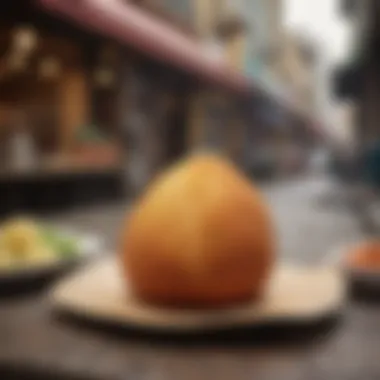Exploring the Cultural and Culinary Roots of Coxinha


Intro
Coxinha is more than just a snack in Brazil; it represents a significant piece of the country's culinary fabric. Originating from the late 19th century, this beloved treat has transformed into a symbol of Brazilian gastronomy. Seen on the streets of São Paulo, served at parties, and even found within gourmet restaurants, coxinha appeals to all ages and backgrounds. Its blend of flavors and textures showcases the creativity of Brazilian cuisine while reflecting regional variations that enrich its story.
Recipe Overview
Recipe Name
Coxinha
Description of the Dish
Coxinha is typically shaped like a little chicken drumstick, featuring a crisp, golden-brown exterior made from wheat flour. Inside, a tender filling of shredded chicken often mixed with spices and a creamy touch of cream cheese awaits. This combination results in a delightful contrast of crunch and softness, making it a favorite for both snacking and mealtime. The preparation process highlights various cooking methods, often involving frying, which contributes to the unique texture and flavor of each bite.
Ingredients
List of Ingredients with Measurements
- 2 cups of wheat flour
- 2 cups of chicken broth
- 1 cup of shredded chicken
- 1/2 cup of cream cheese
- 1/2 onion, finely chopped
- 2 cloves of garlic, minced
- 1 egg
- Bread crumbs for coating
- Salt and pepper to taste
- Oil for frying
Special Notes on Ingredients
- The shredded chicken can be substituted with other proteins like beef or even vegetables for a vegetarian version.
- Regional variants may include different spices or additional ingredients, such as corn or olives, offering unique tastes found in various parts of Brazil. The choice of broth can also influence the final flavor, with some opting for homemade stock for a richer taste.
"Coxinha is often seen as a comfort food, evoking memories of family gatherings and celebrations in Brazil."
Understanding the ingredients allows for customization and variation, reflecting personal tastes and preferences for the perfect coxinha.
Prelude to Coxinha
Coxinha holds a special place in Brazilian cuisine. It is more than a mere snack; it embodies cultural heritage and culinary innovation. This introduction sets the stage for understanding how coxinha is woven into the fabric of Brazilian daily life and celebrations. The next sections will dive into its definition, rich history, and its essential elements.
Definition and Description
Coxinha is a popular Brazilian comfort food, traditionally made from shredded chicken enveloped in a dough made from wheat flour and butter. The shape of coxinha resembles a small drumstick, which is believed to be a nod to its chicken filling. The outer layer is often crisp when fried, offering a satisfying crunch that complements the creamy, flavorful chicken filling inside.
The ingredients vary, and some variants include cheese, spices, and even the vegetarian alternatives that incorporate ingredients like mushrooms or vegetables for filling. Coxinhas are often served with spicy sauces for added taste, making them a versatile dish suitable for diverse palates.
Historical Context
The history of coxinha is both intriguing and somewhat debated. Some sources trace its origins to the late 19th century, citing innovation by a Brazilian chef who wished to create a dish to impress his guests. Over the decades, coxinha evolved, transitioning from a festive treat served at parties to a beloved street food. Its popularity surged in urban areas, particularly in São Paulo, during the 20th century.
Coxinha is linked to various regional and cultural practices, as different areas in Brazil have developed their versions, integrating local flavors and ingredients. This transformation highlights its significance not just as a snack but as an icon in Brazilian culinary tradition, marking celebrations and family gatherings.
"Coxinha reflects the Brazilian spirit of creativity and adaptability, blending influences from various cultures while maintaining its core identity."
As one explores the diverse regional variations and the many ways to prepare this dish, the cultural significance of coxinha becomes even more apparent. This snack is not only a culinary staple but also a symbol of community and festivity.
The Ingredients of Coxinha
The composition of the ingredients in coxinha is crucial to understanding its flavor and texture. Coxinha is primarily made from dough and a filling. The balance of these ingredients defines not only the experience of eating the snack but also its nutritional profile. Every ingredient contributes uniquely to the overall taste and cultural background of coxinha. Focusing on the right ingredients can elevate this traditional dish to new heights and allow anyone to appreciate its cultural heritage.
Dough Composition


The dough used for coxinha is a blend of several key ingredients, typically flour, water, butter, and sometimes chicken broth. This composition ensures that the dough is soft yet sturdy enough to hold the filling without breaking. Butter adds richness, while the broth infuses the dough with flavor. It is the fine balance between these elements that results in a satisfying texture; a crispy outer shell enveloping a creamy filling. Therefore, proper dough preparation is essential, as it serves as the foundation of the entire dish.
Filling Variations
Traditional Chicken Filling
The traditional filling of coxinha consists mainly of shredded chicken mixed with various spices and herbs. This filling is significant because it embodies the essence of Brazilian flavors. Chicken provides a distinct savory base, while the added spices create a warm, inviting taste. The texture of the shredded chicken also contrasts nicely with the crispy dough. Enjoying coxinha with this filling is a common preference due to its familiarity and comforting nature.
Vegetarian Alternatives
Vegetarian alternatives for coxinha fillings have gained popularity, reflecting dietary preferences and the need for inclusivity in cuisine. Common vegetarian fillings include cheese, mushrooms, and vegetables like spinach or pumpkin. This variation adds a vibrant twist to the traditional dish while maintaining a hearty experience. The key characteristic of these alternatives is their ability to blend rich flavors and textures, making them appealing to a larger audience.
Regional Specialties
Regional specialties in coxinha fillings highlight the diversity of Brazilian culinary traditions. For instance, some areas may use duck or fish instead of chicken. These local variations showcase the adaptation of coxinha to incorporate regional ingredients and preferences. The key characteristic of regional specialties is their unique flavors, allowing for a new experience with each bite. However, some of these fillings may not resonate with everyone due to more intense or unfamiliar flavors.
The ingredients of coxinha not only provide its distinctive flavor but also represent the rich tapestry of Brazilian culture and tradition.
Preparation Techniques
The preparation techniques used for making coxinha are vital in understanding its culinary significance. The process of creating this iconic Brazilian dish requires precision and a keen sense of balance between ingredients. Each step, from dough making to frying, contributes to the final taste and texture. This section will explore three essential stages of preparation: making the dough, preparing the filling, and shaping and frying the coxinha. Each stage is important not just for technical reasons, but also for the appreciation of this cultural delicacy.
Making the Dough
Making the dough is one of the first and most significant steps in coxinha preparation. It is essential because the dough must be pliable yet firm enough to hold the filling without falling apart during cooking. The traditional coxinha dough is made from flour, butter, and chicken broth, providing both flavor and moisture.
The steps involved in making the dough include:
- Boiling the Chicken Broth: Start by boiling chicken to create a rich broth that will infuse flavor into the dough.
- Incorporating Ingredients: Gradually mix the flour and butter into the hot broth. This ensures the dough absorbs moisture effectively.
- Kneading: Kneading is crucial to achieve the right texture; it should be smooth and elastic.
Achieving the right consistency in the dough is critical. The balance of ingredients impacts how the coxinha will fry and taste. A well-prepared dough can elevate the entire dish.
Preparing the Filling
This stage involves creating the filling that will define the coxinha's character. The traditional filling is typically made from shredded chicken, seasoned with onions, garlic, and spices. However, there are many creative variations that cater to different tastes, including vegetarian options and unique regional specialties.
Steps to prepare the filling involve:
- Cooking the Chicken: Boil and season the chicken until tender, then shred it into fine pieces.
- Sautéing Vegetables: Sauté onions and garlic to add depth to the flavor. It is important to not rush this step, as proper caramelization enhances taste.
- Mixing Ingredients: Combine the chicken with the sautéed vegetables and spices, ensuring the mixture is well-blended and flavorful.
The filling encapsulates the essence of coxinha. A well-seasoned filling can transform a simple dough ball into an exquisite culinary treat.
Shaping and Frying
Shaping and frying are the final steps in the coxinha preparation. These stages require skill to ensure that the coxinhas hold their shape and achieve the desired crunchiness during frying.
The steps involved include:
- Forming the Coxinhas: Take a portion of the dough and flatten it in the palm of your hand. Add the filling and fold the dough over, sealing it securely. This step is essential for preventing the filling from leaking out while frying.
- Coating in Batter: Dipping the formed coxinhas in egg and then breadcrumbs gives them a crispy exterior when fried.
- Frying: Heat oil to the right temperature before adding the coxinhas. This ensures they cook evenly and develop a golden-brown color.
The technique of frying coxinha cannot be underestimated. It is this step that brings together all the previous efforts into a cohesive and satisfying snack.
Regional Differences in Coxinha
Coxinha is more than just a snack in Brazil; it is a culinary canvas shaped by diverse regional influences. Each area has its own unique take on coxinha, resulting in an array of flavors and textures. Understanding these regional differences adds depth to our appreciation of this dish. The variations reflect local ingredients, cultural influences, and cooking techniques that define the identity of each region.


Coxinha from São Paulo
In São Paulo, coxinha is recognized for its rich taste and size. The dough tends to be softer, allowing for a delightful contrast with a filling that is often packed with shredded chicken. Vendors may add spices like nutmeg or saffron to heighten the flavor profile. It's common for coxinha in this region to be larger than in other parts of Brazil, making it a satisfying snack. Variations may include cream cheese or other rich ingredients mixed into the filling, creating a creamy texture that enhances the overall experience. São Paulo coxinhas have become iconic, often served at parties and celebrations.
Coxinha in Bahia
Bahia's approach to coxinha embodies its diverse culinary heritage. The Bahia version often incorporates dendê oil, which lends a distinct flavor to the dough and filling. Additionally, this region embraces local ingredients like shrimp or spicy peppers in the filling. This renditoin reflects the African and Indigenous influences that characterize Bahian cuisine. The coxinha is typically smaller, more akin to bite-sized pastries. The integration of regional spices and ingredients results in a more intense and aromatic experience, appealing to those who seek depth in flavor.
Coxinha Variations in the North
In Northern Brazil, coxinha takes on innovative forms that reflect local tastes and customs. Here, it is commonplace to find variations that utilize fish, such as cod or tilapia, as the primary filling. The dough may also have a slightly different consistency, adapted to the cooking practices of the region. Some chefs have begun experimenting with unique spices and herbs, showcasing the area's agricultural products.
The creativity and resourcefulness of Northern cuisine are evident in these variations, making each bite not just a taste of coxinha but an exploration of the region's identity.
"Regional differences in coxinha exemplify not just diverse culinary practices, but a deeper cultural tapestry that binds Brazilians together in their love for this iconic snack."
Understanding the regional differences in coxinha opens a door to explore the complex nature of Brazilian gastronomy. Each style tells a story, highlighting the interplay between local culture and culinary traditions.
Coxinha in Modern Cuisine
Coxinha has transcended its humble origins, evolving into a prominent fixture in modern culinary landscapes. Its versatility allows it to fit into various dining contexts, making it a beloved choice for food lovers. The appreciation for this snack has grown, as chefs and restaurateurs experiment with its traditional essence while introducing innovative twists that resonate with contemporary palates. The cultural significance of coxinha also reflects the dynamic nature of Brazilian cuisine, as it increasingly finds a place on international menus.
Fusion Dishes
In recent years, fusion cuisine has gained traction, and coxinha serves as a prime candidate for such culinary experimentation. By amalgamating traditional techniques with diverse global flavors, chefs create dishes that are both familiar and novel. For instance, some restaurants have begun to infuse coxinha with atypical fillings, such as spiced lamb or Thai-inspired peanut sauce. This creative approach not only maintains the essential characteristics of coxinha but also invites new audiences to appreciate it.
Consider how coxinha has found its way into gourmet settings by being served with an array of sauces, including sriracha or chipotle aioli. The use of non-traditional ingredients transforms the classic snack into an exciting appetizer and opens conversations about its adaptability. The fusion of cultures represented in these dishes further highlights Brazil's extensive culinary influence, expanding coxinha’s reach beyond its geographic roots.
Coxinha in Food Trucks
The food truck movement has significantly contributed to the growing popularity of coxinha. These mobile kitchens offer an accessible way for locals and tourists to experience diverse cuisines, and coxinha fits seamlessly into this landscape. Many food trucks have emerged, focusing exclusively on Brazilian street food, with coxinha taking center stage.
Food trucks provide a unique platform to showcase coxinha in innovative ways. For example, some trucks offer coxinha sliders, featuring mini coxinhas served on a bun, paired with a selection of toppings. This creative format appeals to a broader audience, especially those looking for quick yet fulfilling meals.
Moreover, the casual dining atmosphere of food trucks allows a relaxed and social experience. Customers can enjoy freshly prepared coxinha while exploring food festivals or local events, contributing to a vibrant culinary culture.
In summary, coxinha's place in modern cuisine highlights its evolving nature and adaptability. As it garners attention in fusion dishes and food trucks, this traditional snack not only persists but thrives, uniting ingredients and culinary practices across cultures.
Cultural Significance of Coxinha
Coxinha holds a unique place in Brazilian culture, embodying both culinary tradition and contemporary social rituals. This savory snack represents more than just a dish; it reflects the social fabric of Brazil, where food plays a pivotal role in gatherings and celebrations. Understanding its cultural significance helps to appreciate its integral role in social interactions and community bonding.
Coxinha as a Party Snack
Coxinha is a common feature at social events in Brazil, often served at parties and gatherings. In many ways, it is synonymous with celebration and joy. Whether it’s a child's birthday party or a family gathering, coxinhas are generally present on the table. Their hand-held nature makes them ideal for social settings, allowing guests to enjoy them without the need for formal dinnerware.
People enjoy the tactile experience of eating coxinhas. They represent a form of comfort food, evoking nostalgia and warmth. This snack facilitates conversation and a sense of togetherness. Preparing coxinha can be a communal activity, where family and friends gather in the kitchen to create these snacks, reinforcing connections and shared heritage.
"Coxinha embodies the spirit of Brazilian gatherings, serving not just as food, but as a means of connection and celebration."
Coxinha in Brazilian Celebrations
Coxinha often plays a role in traditional Brazilian celebrations, including weddings, graduations, and holidays. During festive occasions like the Festa Junina, coxinha is not merely a side dish but a main attraction. Its presence at these events is a testament to its status within Brazilian culinary culture.


Each celebration brings with it unique variations of coxinha, reflecting the diverse regional influences present in Brazil. For example, during Carnival, street vendors offer coxinhas filled with exotic ingredients, adapting to the exuberance of the event. This flexibility not only speaks to the creativity involved in Brazilian cuisine but also underscores coxinha’s identity as an adaptable and beloved snack in various settings.
Thus, coxinha represents a thread that weaves through the fabric of Brazilian life, celebrating shared culture, communal values, and culinary artistry. It leaves a mark on the memory of gatherings, making every occasion just a little more special.
Nutritional Aspects of Coxinha
Understanding the nutritional aspects of coxinha is crucial for a balanced view of this traditional Brazilian snack. As food lovers explore coxinha, it is important to recognize both its caloric content and potential for healthier modifications. Such insights allow consumers to appreciate this snack while being mindful of their dietary choices.
Caloric Content
Coxinha is often seen as a comfort food, characterized by its crispy exterior and savory filling. However, this enjoyment comes with a caloric cost. A typical coxinha can range from 150 to 300 calories per piece, depending on the specific ingredients used and the cooking method.
This caloric density can pose challenges for those managing their weight or caloric intake. It's essential to consider the portion size when indulging in coxinha. The combination of dough and filling, while delicious, often contains substantial amounts of carbohydrates and fats, which contribute to its overall energy density.
"A comprehensive understanding of caloric content forms a basis for making informed dietary choices regarding coxinha."
More particularly, coxinha's traditional chicken filling adds protein, which can provide some nutritional balance. However, fried versions significantly increase fat content. Thus, coxinha's caloric composition varies widely based on the recipe and the cooking oil used for frying.
Healthier Modifications
As interest in health and nutrition increases, many people seek healthier modifications of traditional dishes like coxinha. Adapting recipes can help maintain the essence of coxinha while making it suitable for a wider range of dietary needs.
- Baked options: Instead of frying, baking coxinha can substantially reduce the fat content. This method allows the snack to retain its crunch while lowering calories.
- Alternative fillings: Substituting the traditional chicken filling with vegetables, legumes, or lean meats like turkey can enhance the fiber and nutrient profile. This variety not only supports plant-based diets but also adds different flavors.
- Gluten-free dough: For those with gluten sensitivities, using gluten-free flour allows more individuals to enjoy coxinha without compromising their dietary requirements.
In summary, understanding the nutritional aspects of coxinha is pivotal for both consumers and chefs alike. Making informed decisions around its preparation and adaptation can ensure that this beloved snack remains a delightful part of Brazilian cuisine while aligning with health-conscious lifestyles.
Coxinha in Global Context
Coxinha, a staple of Brazilian cuisine, has garnered attention well beyond its geographic roots. As migration patterns and globalization have contributed to cultural exchanges, coxinha has adapted to various culinary environments around the world. Understanding coxinha in a global context reveals not only its appeal but also the ways it has evolved to meet diverse palates. Importantly, the significance of coxinha extends beyond mere enjoyment. It embodies the fusion of cultures, flavors, and culinary techniques, illustrating how one dish can resonate globally while maintaining local integrity.
Coxinha's Popularity Outside Brazil
In recent years, coxinha has carved a niche for itself in cities far from Brazil. Its popularity can be attributed to a few key factors:
- Culinary Versatility: The adaptability of coxinha allows it to be interpreted in various ways. From traditional chicken to avant-garde fillings, it caters to a broad audience.
- Street Food Culture: The global rise of food trucks and street food has provided an ideal stage for coxinha. It is often featured in trendy food markets, drawing interest from a diverse clientele.
- Cultural Events: Brazilian festivals and events abroad serve as platforms for introducing coxinha to international crowds, providing both culinary and cultural education.
Reports show that Brazilian expatriates and food enthusiasts continuously seek authentic coxinha, leading to the establishment of dedicated shops across the globe.
International Variations and Inspirations
As coxinha spreads globally, variations have emerged, reflecting local tastes and ingredients. Notable adaptations include:
- Asian Influence: In certain Asian countries, coxinha is reimagined using local spices and cooking methods. For example, some versions may incorporate curry or fried tofu as a filling, showcasing a fusion of Brazilian and Asian culinary techniques.
- European Twists: In parts of Europe, coxinha has attracted attention in gourmet restaurants. Here, chefs may experiment with fillings such as truffle-infused cheese or organic vegetables, elevating the snack to a fine dining experience.
- Vegetarian and Vegan Adaptations: In response to growing dietary preferences, many outlets offer vegetarian and vegan versions of coxinha. These adaptations often involve creative fillings like mushroom, beetroot, or lentils, broadening its appeal farther.
"Coxinha's transcendence from a local snack to an international favorite demonstrates the power of food as a universal language."
Through these transformations, coxinha retains its identity as a Brazilian classic while resonating with various food cultures. This balance between tradition and innovation highlights coxinha's role in the network of global gastronomy. In summary, coxinha's integration into the culinary landscapes of other nations reflects not just its taste but also the ongoing dialogue between different cultures, enriching the global food tapestry.
Culmination
In this article, we have explored the rich tapestry that surrounds coxinha. This traditional Brazilian snack commands a significant place in both culture and cuisine. Recognizing its multifaceted nature helps deepen our appreciation for Brazilian culinary identity.
The Enduring Appeal of Coxinha
Coxinha far surpasses its role as mere food. It stands as a symbol of community and celebration. From birthday parties to holiday gatherings, this delicacy is often at the heart of joyful occasions. Its crunchy exterior and savory filling create an irresistible combination that appeals to a wide array of palates.
This snack has transcended its humble origins, gaining popularity not only within Brazil, but also internationally. The adaptability of coxinha, with its various fillings and preparation styles, allows it to resonate with diverse culinary tastes around the world.
Coxinha exemplifies the essence of Brazilian cuisine: a harmonious blend of flavors, textures, and cultural heritage.
The shifts in preparation, presentation, and even filling reflect contemporary trends, yet they preserve the fundamental spirit of the dish. Thus, the enduring appeal of coxinha lies not just in its deliciousness, but in its ability to bring people together, making it a cherished part of both Brazilian socialites and global gastronomy.







